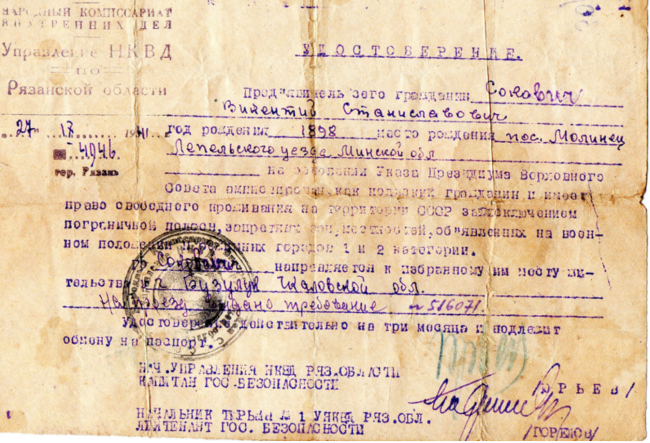The 1st Independent Polish Parachute Brigade
(1 Samodzielna Brygada Spadochronowa)
Amnesty For Polish Citizens
In The USSR
Release Of The Polish Captives In 1941
The "Amnesty For Polish Citizens In The USSR"
On August 12, 1941, it was broadcast by radio that, in pursuance of the Polish-Soviet treaty, the presidium of the USSR Supreme Soviet declared an amnesty for Polish citizens in the USSR.
Thus, for the thousands of masses of Poles, scattered over the endless expanses of the Soviet land, the days of uncertainty, days without gleam, and nights without sleep ended.
Delay in Release Of The Polish Citizens In The USSR
The amnesty (Release Of The Polish citizens in the In USSR) in July 1941 didn’t immediately lead to the release of all Poles in exile in the USSR.
This was due to two main factors 1) The Russians were slow and in many cases deliberately stalling telling Poles they were free and 2) They needed money and food in order to make the journey, trouble was it was winter and travel over vast distances very uncertain.
Thus the majority of captive Polish citizens in the USSR, Siberia, Kazakhstan and Altayski Kray remained in their place of exile. However those in Archangelsk & Komi decided to move south where it was warmer, typically they went to the Tashkent area, where at a later stage the Polish Army (Anders army) was situated and increasing in size.
Unfortunately, neither Poland nor the UK wanted to assist in the rescue of the captive Polish citizens in the USSR.
Although in principle Stalin had agreed to the release of captive Polish citizens in the USSR, the Russians, specifically the NKVD, were not prepared to suddenly turn martyr on the captive Polish citizens in the USSR. Thus there were delays in conveying that the Poles were free, not all were told about it, some became aware weeks later.
Neither was the USSR keen to financially assist Poland, so it took till December 1941 before Russia agreed to lend Poland the money (100 million rubles) to pay for the Exodus. Yes, taking them prisoner was for free, but releasing them, well Poland would have to pay for that travel privilege!
Confusion
General Anders was from August to December 1941 still in the process of forming the various divisions of the Polish Army in Exile (Anders Army) and so for around 4 months, even though the captive Polish citizens in the USSR were free, they could not make it back to Poland and they also didn't necessarily have a place to go to.
There was also the travel, money and food factor to be considered should any Polish person wish to make the long trip of around 1500 miles south to a recruitment point.
Thus many former captive Polish citizens in the USSR continued to stay in exile at their labour camps and collective farms for weeks, even months. However, as long as they stayed there they were expected to work as per usual because in the Soviet Union "If you don't work, you don't eat".
Leaving The Gulags
By spring 1942 the money started to reach the deportees.
This was just as well as Russia was struggling to finance the feeding of the deportees. This is likely a leading reason why they organised fast and efficient transport to get all the Poles out of the USSR as it would save them money.
Every Polish person that was released was issued with documents that would allow them to travel within the USSR but not to cross it's borders.

Eventually, some former captive Polish citizens in the USSR put together travel plans (travelling in groups) whilst at other collective farms and labour camps they were directly recruited i.e transport was organised and notice was sent to that location of the day and time they could expect transport to take them south to a recruitment point.
Some in Archangelsk & Komi decided to move south where it was warmer, typically they went to the Tashkent area, where at a later stage the Polish Army was situated and increasing in size. There were also specific attempts by Polish Command to arrange transport for former captive Polish citizens in the USSR in Archangel and to bring them south to recruitment points.
The Soviet authorities, on this occasion, supplied heated railway carriages as well as 14 days of food rations to keep them going as they headed south.
The saddest part of the whole "amnesty" saga is that Poles suffered 2 major setbacks. The first was that if your travel papers were not completely in order they would simply detain you and you would be eternally stuck in the Soviet Union.
The second setback was that even if your travel (to Krasnovodsk, the extraction point) went successfully, you might still be stuck in the Soviet Union after Stalin closed the borders following the Katyn Forrest Massacre.
Recruitment Camp Life
Once the Polish soldiers reached the recruitment points and signed up they were admitted to camps. At the camps training, drills and suchlike took place in preparation of fighting the Germans.
However, due to their experiences in the Gulags, severe malnutrition and a lack of food, many Polish soldiers were severely weak and ill.
General Anders had meetings with Stalin but he could never get enough rations to care for the soldiers and so began a standoff between Anders and Stalin.
Relations With Russia Sour
Stalin expected something for nothing out of Anders and his army. Stalin failed to provide adequate food, munitions, clothing and suchlike for the Polish soldiers and despite protests from Anders, little was resolved, in fact, the soldiers continued suffering from poor health and malnutrition.
General Anders Starts To Turn
A plan was hatched by General Anders, with the assistance of Britain, to evacuate all the Polish Soldiers (and civilians) from the Soviet Union.
Some would go back to Poland, others elsewhere. Note that at this point Stalin is working with Britain and Poland over this plan.
Please Donate!

Uncover The Past - Support The Future
Please don't "grab & go"! Each year, 12,000 people visit this website to trace their Polish ancestry, uncover family stories, and connect with their roots. I believe that history should be accessible to all - but keeping this website alive since 2017 comes at a personal cost to me, 8 years @ £1000 per year (website mgt fees) has left an £8000 dent...with only £380 in total donated up to 27/11/25 😱😱😱.
Every detail you uncover and every story you piece together helps you piece family history together. Please donate if you found the existing information on this site useful, help me keep the site alive! Thanks! Jason Nellyer (Researcher & Site Owner)